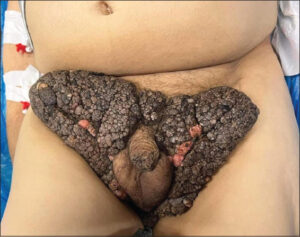Giant condyloma acuminata
Eleni Klimi 1, Maria Nektaria Giannakaki2
1, Maria Nektaria Giannakaki2
1Department of Dermatology Thriassio General Hospital, Magoula Athens Greece, 22nd Department of Internal Medicine Thriassio General Hospital, Magoula Athens Greece
Citation tools:
Copyright information
© Our Dermatology Online 2024. No commercial re-use. See rights and permissions. Published by Our Dermatology Online.
A sixty-year-old patient was hospitalized at the Second Department of Internal Medicine for the investigation of anemia. B12 deficiency was revealed, and the relevant supplementation was initiated. A clinical skin examination revealed a huge, brown, polypoidal mass covering the entire inguinal area that had been there for the last nine years (Fig. 1). Neither rectal nor anal lesions were observed. During hospitalization, the patient was infected with COVID-19 and, after treatment, was discharged from the hospital without any further dermatological consultation. Laboratory examination for syphilis and HIV was negative. It was a giant condyloma acuminata.
Giant condyloma acuminata is a rare disease affecting 0.1% of the population, mainly immunocompromised patients suffering from diabetes, cancer, following transplantation, and is associated with HPV 6 [1] and 11 strains yet also 16 and 18, the high-risk ones [2]. It often recurs and may be transformed into squamous cell carcinoma. Treatment includes immunomodulator agents such as imiquimod, surgical excision, and non-invasive methods such as local hyperthermia [3].
Final diagnosis: giant condyloma acuminata.
Three differential diagnoses: skin tags, molluscum contagiosum, condyloma latum.
Consent
The examination of the patient was conducted according to the principles of the Declaration of Helsinki.
The authors certify that they have obtained all appropriate patient consent forms, in which the patients gave their consent for images and other clinical information to be included in the journal. The patients understand that their names and initials will not be published and due effort will be made to conceal their identity, but that anonymity cannot be guaranteed.
REFERENCES
1. Nassiri A, Aqil N, Baybay H, Mernissi FZ, Souhli OA, Ahssaini M, et al. Extra genital HPV-6. Our Dermatol Online. 2019;10:71-3.
2. Bachaspatimayum R, Zamzachin G, Devi TB. Clinical and laboratory profiles of genital ulcers (sexually transmitted diseases) in a tertiary care center in northeastern India. Our Dermatol Online. 2021;12:120-9.
3. Ganjoo S, Mishra P, Sawhney MPS, Sharma U, Chhabra N. Successful ablation of giant condyloma acuminata in an adolescent. Our Dermatol Online. 2021;12:430-2.
Notes
Request permissions
If you wish to reuse any or all of this article please use the e-mail (brzezoo77@yahoo.com) to contact with publisher.
| Related Articles | Search Authors in |
|
 http://orcid.org/0000-0001-5113-5640 http://orcid.org/0000-0001-5113-5640 |





Comments are closed.